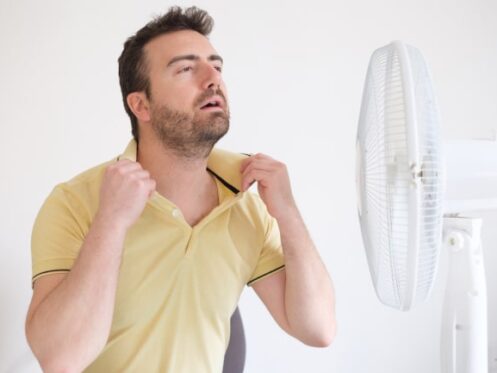Is installing a dehumidifier the best option for reducing relative humidity inside your home? The answer is “sometimes, but not always.”
How’s that for ambiguity?
A dehumidifier, whether a standalone unit or a “whole house” system, could be your first choice for moisture control or your last choice. It all depends on:
- your goals for indoor comfort
- the leakiness of your building envelope
- your budget for comfort improvements
In some cases, you can make improvements to your home that entirely negate the need for supplemental dehumidification! Other times, a dehumidifier is exactly what you need to stay comfortable during the humid summer months.
What does a dehumidifier do?
A dehumidifier removes moisture from the air inside your home. Here in Georgia, many people operate dehumidifiers during the sultry spring and summer months to create a drier indoor environment:
- A dry indoor environment virtually eliminates the risk of mold. If you have a hard time maintaining a relative humidity level of 65% or less, your home could be at risk for mold growth.
- Drier air is more comfortable than humid air. High humidity during the summer makes you feel hotter than you otherwise would. Removing moisture from indoor air makes you feel more comfortable. Somewhere between 40% and 50%, relative humidity is ideal for most people.
While a dehumidifier helps you mitigate mold risk and create a drier indoor environment, it doesn’t always address your humidity problem at the source.
Your home is probably leaky.
Humid air enters your home from the outdoors. If you keep your doors and windows closed and it’s still humid inside your house, that humid air is coming in from somewhere else.
The most likely culprits are your crawl space and your attic, but only an energy audit will let you know for sure.
To understand how humid air enters and lingers inside your home, it’s important to understand the concept of the building envelope – the moisture, thermal, and air barrier between your living environment and the outdoors. We’ve written about the building envelope before, but here’s what you need to remember when it comes to humidity:
- High humidity is often the result of an insufficient, or “leaky,” building envelope.
- Air sealing the big gaps and cracks in the envelope will help keep humid air out of your house.
- Sealing doors and windows usually isn’t enough. The big gaps and cracks are probably at the top (attic) and bottom (crawl space) of the envelope.
In many cases, a dehumidifier is a band-aid solution for a leaky envelope. Seal the envelope, and there’s a good chance you’ll solve your humidity problem!
Your air conditioner might be too big.
Willis Carrier invented the air conditioner in 1902, but he wasn’t trying to help people stay cool in hot weather. He was actually trying to dehumidify the air inside a printing facility to maintain the integrity of the ink. Air conditioning was the unintended – yet much appreciated – result of Carrier’s efforts!
Suffice it to say, your air conditioner is also a dehumidifier. But unless you use a thermostat that senses humidity, your AC will only respond to your temperature settings, not the relative humidity of your indoor space. It dehumidifies the air inside your home whenever it runs, but it only runs when the indoor temperature would otherwise be too high.
If your home has a properly sized air conditioner, preferably a variable-speed compressor that runs more frequently than older, single-speed units, dehumidification from supply air are often sufficient to keep relative humidity below 55%. Unfortunately, many HVAC contractors install air conditioners that are way too big:
- When your air conditioner is too big, it cools your home too quickly. Since the AC is powerful, it doesn’t take very long to cool a large space. As a result, it never runs long enough to reduce humidity levels.
- If you have an oversized AC, you need to lower the thermostat to reduce humidity. By lowering the temperature on your thermostat to reduce humidity, you end up with higher energy bills.
What does all of this mean concerning dehumidifiers? If you think you need a dehumidifier, you might just have an oversized air conditioner, a leaky home, or both.
When should you use a dehumidifier?
Good question! Dehumidifiers are useful in the following situations:
1. Your AC is too big, but you’re not ready to replace it.
Maybe your oversized air conditioner is only a few years old and you don’t have the budget or the desire to replace it right now. How will you reduce relative humidity indoors without setting your thermostat to the low 70s?
Installing a whole-house dehumidifier inside your existing HVAC system is often the answer. It’s less expensive than installing a variable-speed AC, and it solves the humidity problem. As a result, you can adjust your thermostat to a higher temperature.
2. You want to improve indoor air quality.
A lot of homeowners ask us whether energy recovery ventilators (ERVs) are the best choice for improving indoor air quality. While an ERV will improve indoor air quality, it won’t help you reduce humidity. And since many indoor air quality problems stem from excessive humidity inside the home, an ERV isn’t always the best choice.
What is the best solution? A whole house dehumidifier with a fresh air system! The fresh air system brings in (and filters) outdoor air, which is dehumidified before it enters your living space. The result is low humidity and cleaner indoor air.
3. You have an encapsulated crawl space.
Code for “closed” or “encapsulated” crawl spaces requires a drying mechanism, and a dehumidifier is the most effective solution for keeping relative humidity at a healthy level.
However – and we mention this because we’ve seen it many times – avoid running a dehumidifier in a vented crawl space or in a basement that is connected to a vented crawl space! You’re trying to dehumidify the outdoors, which is a battle you’re guaranteed to lose.
It’s kind of like rolling down all the windows in your car and blasting the AC. It just doesn’t work.
4. You’ve already made the requisite energy improvements.
Air-sealed your home. Installed a properly sized, variable-speed air conditioner? If you still have high humidity, you might need a dehumidifier. A whole house dehumidifier or standalone unit will work.
Not sure whether you need a dehumidifier? That’s why we do audits!
If you’re ready to eliminate high indoor humidity, PV Heating, Cooling & Plumbing‘s whole home energy audit will reveal how humid air gets into your home, why it’s lingering, and what you can do to reduce it.
We’ll also show you the best opportunities to tighten your home envelope and improve indoor comfort. Contact us today to schedule a consultation!

